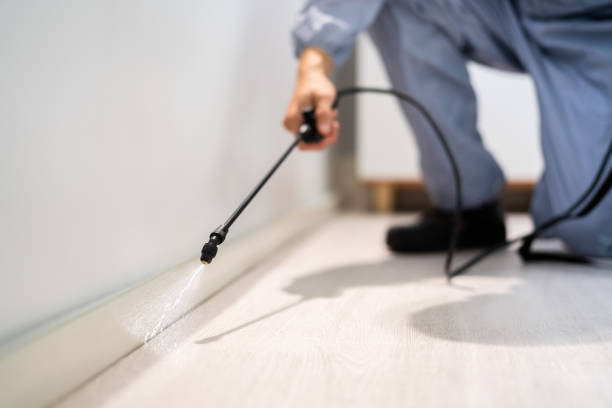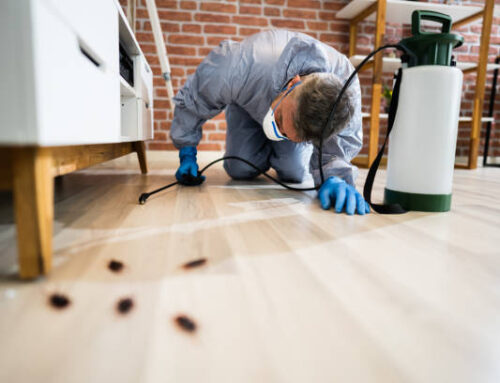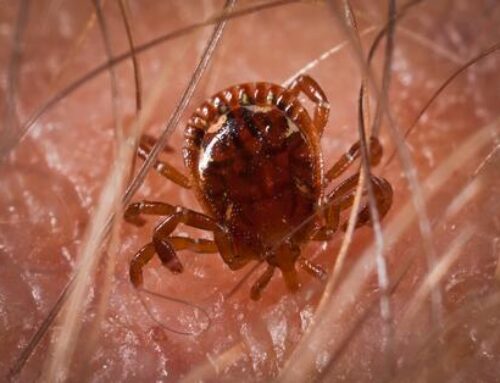Rodents are among the most persistent and destructive household pests. Once they enter a home, they multiply quickly, gnaw through materials, and contaminate surfaces with droppings and urine. Many homeowners attempt to handle the issue themselves using store-bought rodent traps. While this approach might seem convenient, it rarely addresses the full extent of the problem.
Rats and mice are intelligent, adaptable creatures. They learn to avoid traps, hide in unreachable spaces, and find alternative food sources. Trapping a few individuals may provide temporary relief, but the root causes of infestation often remain untouched. True elimination requires identifying entry points, food attractants, and nesting zones; tasks that go far beyond the reach of most DIY methods.

Pest Control Exterminator Man Spraying Termite Pesticide In Office
The Limitations of Store-Bought Rodent Traps
At first glance, rodent traps appear simple and affordable. Many homeowners believe that setting a few devices in key areas will stop the issue. However, these tools are designed for isolated cases, not large or recurring infestations.
The main limitations include:
- Incorrect placement: Rodents often travel along walls, behind furniture, or through narrow voids. Without understanding their movement patterns, traps are ineffective.
- Inadequate quantity: A few traps cannot control a growing population, especially when breeding nests are hidden deep within insulation or structural gaps.
- Human scent detection: Rodents can detect and avoid traps touched by human hands. Even subtle odors can trigger avoidance behavior.
- Limited bait success: Not all rodents respond to the same bait. Some species require specific attractants or combinations of scent cues.
Most importantly, store-bought traps fail to address the broader infestation. If entry points remain open, rodents will continue to enter, bringing the same problem back again.
Why Rodents Outsmart DIY Efforts
Rodents are highly adaptive. Their intelligence and survival instincts make them difficult to control using simple trapping methods. Studies have shown that rodents quickly learn to associate traps with danger, especially after seeing others caught.
Additionally, many infestations involve multiple nesting sites and interconnected pathways. Rodents can nest within walls, attics, basements, or crawlspaces: areas often inaccessible without specialized tools. In such environments, setting traps becomes guesswork.
Homeowners may also overlook early warning signs of reinfestation. For instance, droppings behind appliances or faint scratching in walls often go unnoticed until populations grow significantly. By that point, traps alone cannot resolve the issue. Regular monitoring and professional inspection are necessary to prevent recurring infestations. For insight into the benefits of ongoing prevention, explore this guide on why regular pest inspections save money.
The Hidden Risks of Incomplete Removal
Even if DIY rodent traps catch a few individuals, the unseen consequences can still be serious. Incomplete or improper removal allows contamination, disease, and structural damage to persist.
Key risks include:
- Health hazards: Rodents spread diseases such as hantavirus and salmonella through droppings and urine. Inadequate cleanup can expose residents to illness.
- Lingering odors: Dead rodents trapped in walls or inaccessible areas create foul smells and attract other pests like flies.
- Structural damage: Rodents chew through insulation, electrical wiring, and wood, increasing the risk of fires and costly repairs.
- Population rebound: Without targeting nests or breeding areas, the remaining rodents continue reproducing, rebuilding colonies within weeks.
Professional pest technicians not only remove rodents but also sanitize affected areas, seal entry points, and monitor for continued activity, ensuring that the issue does not return.
Why Professional Rodent Management Is More Effective
Effective rodent control depends on three key elements: identification, exclusion, and monitoring. Traps alone achieve none of these in a lasting way.
Professionals use advanced techniques and industry-approved tools to eliminate rodents at their source. Their process includes:
- Inspection and identification: Determining the species involved helps tailor the control method for maximum success.
- Entry point sealing: Professionals locate and close all structural openings, from vents to cracks, that allow rodents access.
- Targeted placement: Technicians strategically position traps or bait stations based on behavioral mapping.
- Sanitation and monitoring: After removal, they sanitize affected areas and implement follow-up checks to ensure lasting results.
This comprehensive approach targets not just visible rodents but also their hidden nesting zones and potential future entryways. It replaces guesswork with a data-driven strategy.
In some environments, quarterly pest control plans provide even stronger protection. These are especially useful in regions with unpredictable climate shifts that affect pest behavior.
Long-Term Prevention and Peace of Mind
A single mouse or rat sighting often means several others remain unseen. Rodents are nocturnal and secretive, and they reproduce quickly. Addressing infestations early prevents them from expanding into full colonies.
Long-term prevention involves more than occasional trapping. It includes consistent inspection, proper storage of food and waste, sealing of vulnerabilities, and routine professional maintenance. Over time, these practices create an environment that is far less hospitable to rodents.
Professionals also provide detailed reports and recommendations that help homeowners maintain cleanliness and minimize attractants. These preventive insights are invaluable for avoiding future infestations and ensuring that structural integrity remains intact.
Stop Rodents Before They Take Over
DIY traps may catch a few pests, but they rarely eliminate the source of infestation. For thorough removal, sanitation, and prevention that lasts, contact E&G Exterminators.






